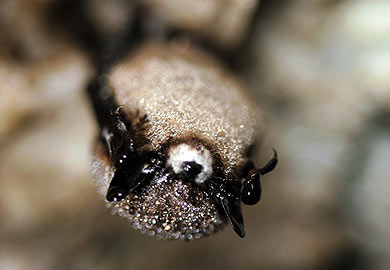DNR News
** Archived Article - please check for current information. **
June 30, 2014
Bat disease white-nose syndrome jumps from mountains to Midlands in South Carolina
The S.C. Department of Natural Resources recently received confirmation that white-nose syndrome, a disease that has killed millions of bats in eastern North American, has been confirmed in a tri-colored bat in Richland County. Previously, the only known cases of the disease in South Carolina had been found in the mountain counties of Pickens and Oconee.
Mary Bunch, wildlife biologist and statewide bat coordinator with the S.C. Department of Natural Resources (DNR) in Clemson, said the white-nose syndrome (WNS) jump from the mountains to the midlands was really not all that surprising.
"We need to act like many of the true hibernating bats in the entire state are infected," Bunch said. "We can't assume that bats in our coastal region aren't affected anymore. We still hope that in the coastal area, where winters aren't as severe, that we won't lose as many bats to WNS."
WNS has now been confirmed in 25 states, and more than six million bats have been lost in the eastern United States in the past six years. Currently there is no cure or effective treatment for WNS, and mortality in some species, such as the small tricolored bat, has exceeded 98 percent. Bats have very low reproductive rates so recovery from losses takes a long time. Formerly common bats are becoming rare, and some rare bats may be lost. The fungus grows best in a cool moist environment, the same places bats go to hibernate.
Bat species that hibernate in mines or caves are susceptible to WNS. South Carolina has seven of those species: Rafinesque's big-eared bat, big brown bat, little brown bat, small-footed bat, Northern long-eared bat, tri-colored bat and Southeastern bat. So far, two tri-colored bats and one small-footed bat have been found to be infected with WNS in South Carolina. The Rafinesque's bat is not thought to be at risk, Bunch said, because that species is more active in winter with more brief bouts of hibernation. The tiny tri-colored bat is the first species to arrive and the last to leave a hibernaculum, so it has very long exposure to the cold-loving fungus.
A bat often found roosting in homes and buildings in South Carolina, the free-tailed bat, is a colonial species that does not hibernate, and WNS has not been detected in that species.
While WNS is not harmful to humans, scientists know the spores can be transported on clothing and gear, and the U.S. Fish and Wildlife Service advises cavers and researchers to curtail caving activities and implement decontamination procedures in an effort to reduce the spread of WNS. Simply washing clothing will not kill the fungus. The U.S. Forest Service has implemented a 5-year ban on caving on its lands.
Bats play a critical role in maintaining healthy ecosystems and have an enormous impact on pest control, benefitting the economies of both forestry and agriculture in the United States. For example, the one million little brown bats that have already died due to WNS would have eaten between 660 and 1,320 metric tons of insects in one year. A recent study published in Science estimates that insect-eating bats provide a significant pest-control service, saving the U.S. agricultural industry at least $3 billion a year.
People who want to help bats should put up good quality bat boxes on poles or buildings with at least six hours of sun, according to Bunch. That is especially important in developed areas where natural roosts are in short supply.
More News
- S.C. Senate confirms new DNR board chairman, board member
- White catfish record broken on Lake Murray
- Bat disease white-nose syndrome jumps from mountains to Midlands in South Carolina
- DNR courtesy boating inspections for July 4 holiday
- Apply online for deer lottery hunts beginning July 1
- South Carolina Prescribed Fire Council meets Sept. 24-25 in Upstate, to feature Jocassee Gorges tour
- Commercial license needed to sell pen-reared quail
- Now is the time to plant fields for fall mourning dove hunts
- Volunteers needed to participate in the summer turkey survey
- Anglers can help contribute to the collection of Red Snapper data
- Horseshoe Crab spawning season a boon for shorebirds
- Feeding, watering manatees is illegal
- DNR hosts series of youth fishing rodeos/family fishing clinics around the state
- Freshwater fishing trends
- Saltwater fishing trends
- S.C. weekly tidetable
- DNR video
- Archived news releases
